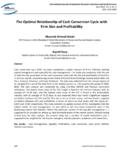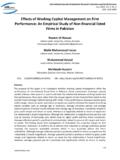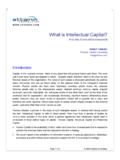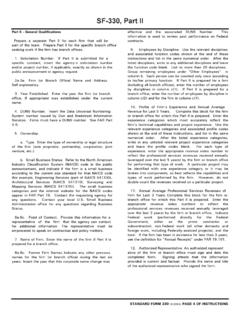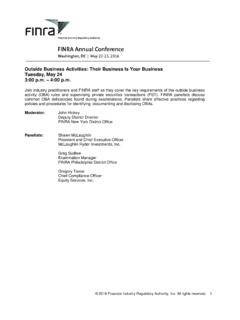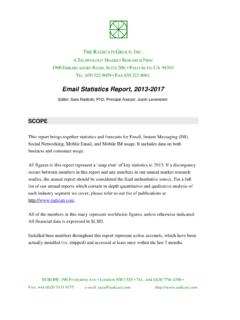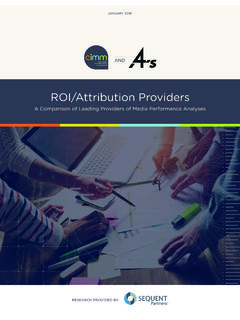Transcription of Sustainability in the Supply Chain - World Bank
1 1 | P a g e Sustainability in the Supply Chain Introduction Supply Chain management (SCM) is the process through which a company manages the sourcing and procurement of inputs, the processing and manufacture of products and services, and their delivery to the consumer (figure 1). The primary objective of Supply Chain management is to meet consumer demand with more efficient use of resources including labor, inventory, stock, and distribution capacity. Accordingly, Supply Chain management aims to integrate major business functions and business processes within and across companies into a cohesive and high-performing business model capable of quickly reacting to dynamic market demands and rapidly changing This guidance note was prepared by Robert Gerrits (Social Development Specialist, CESI).
2 Peer reviewers included Mauricio Athie (Senior Environmental Specialist, CESI), Paolo Lombardo (Senior Environmental Specialist, CESI), David Gibson (Senior Environmental and Social Development Specialist, CESI), and Adriana Triana (Environmental Specialist, CESI). Additional comments and contributions were provided by Anna Hidalgo (Operations Officer, ENVCI), Bilal Rahill (Senior Manager, CESI), Dahlia Lotayef (Program Coordinator, AFTEN), Giovanna Monti (Consultant, CESI), Isabelle Paris (Senior Environmental Specialist, CESI), Jeremy Ansell (Environmental Specialist, CESI), Raymi Beltran (Environmental Specialist, CESI).
3 Editorial assistance was provided by Stan Wanat (Consultant), Juliette Guantai (Program Assistant, ENV) and James Cantrell (Communication Analyst, ENV). The task team leaders for this product are Kulsum Ahmed (Lead Environment Specialist, ENV) and Helena Naber (Environmental Economist, ENV). The product was prepared under the guidance of the following World Bank Group management: James Warren Evans / Mary Barton-Dock (Directors, Environment Department, World Bank), Bilal Rahill (Senior Manager, IFC), and Frank Lysy / Ravi Vish (Director, MIGA). features. SCM provides opportunities through which private sector companies can extend their influence in pollution control and abatement beyond their own operations and into their Supply Chain .
4 This involves coordination and collaboration with partners throughout the value Chain , which can include suppliers, intermediaries, third-party service providers, and customers. The term Supply Chain includes all organizations, activities, and processes associated with all stages of the business processes involved in the planning, sourcing, processing, manufacturing, and delivery of goods and services. This process begins with suppliers of raw materials and inputs, proceeds to processors and manufacturers, and culminates to the delivery of completed goods and services to consumers and end users. The Supply Chain of multinational corporations can be complex, extensive and may be global in nature, whereas the Supply Chain of national or smaller enterprises will be less complex, smaller in scale, and local in nature, involving only local contractors, subcontractors, and home workers.
5 Globalization has led to increased visibility of the environmental and social (E&S) impacts associated with the sourcing and processing of raw materials. Increased visibility has led to heightened consumer awareness and increased demand that firms ensure E&S Sustainability through the entire Supply Chain . 2 | P a g e The key objective of Supply Chain management is to increase the efficiency of the activities and processes involved in the planning, sourcing, processing/manufacture and delivery of goods and services to end consumers. Increased efficiency may be achieved across either part of or the entire Supply Chain and typically is associated with improved productivity, increased product quality, improved logistics and ultimately a reduction in costs.
6 Many aspects of SCM already consider resource utilisation and cost savings. As such the inclusion of a Sustainability dimension in Supply chains and SCM builds on the underlying business case for SCM. Sustainability is thus becoming an integral component of Supply Chain management. There is no single, universally accepted definition of Supply Chain Sustainability and it is often described in general terms through tools like responsible sourcing, green Supply chains and triple value Chain management (TVC), or more generically through corporate social responsibility. The application of E&S Sustainability criteria to Supply chains has focused on physical products such as food and clothing.
7 This focus extends to the sourcing of raw materials, their processing, and their use in the manufacture of intermediate and final products. Description of Supply Chain Management Description of Supply Chain Management. A basic Supply Chain management system has five key components. Primary Source Processing (Intermediate products) Processing (Final products) Consumer Supply Manufacturing Secondary Distribution Potential SCM E&S Sustainability Issues Labor Use Water Use Energy Efficiency Pollution Prevention Biosecurity Social Impacts Such as Indigenous People, Displacement Loss of Biodiversity Forest Conversion and Land Use Sustainable Use of Living Resources Primary Distribution Retailer Figure 1.
8 Generic Illustration of Supply Chain and Potential Sustainability Issues 3 | P a g e 1) Plan The overall strategy of the SCM program including the development of SCM metrics for monitoring; 2) Source Identification, evaluation and selection of suppliers of goods and services; procurement contracting including performance guarantees and targets; and monitoring; 3) Manufacture. Make or manufacturing component, which refers to the execution of processes needed to produce, test, and package your products or services; 4) Delivery. The system for receiving orders from customers, developing a network of warehouses; getting the products to the customers; invoicing customers and receiving payment from them; and 5) Return.
9 A responsive and flexible network for receiving defective and excess products back from customers and supporting customers who have problems with delivered products. There are a number of models to help manage Supply chains, such as Supply Chain Operations Reference model (SCOR), developed by the global Supply Chain Council as a cross-industry standard diagnostic tool for Supply Chain management. The Supply Chain Operations Reference (SCOR ) model is the product of Supply Chain Council (SCC). The SCOR model provides a framework that links business process, metrics, best practices, and technology features into a unified structure to support communication among Supply Chain partners and to improve the effectiveness of Supply Chain management and related Supply Chain improvement activities (available to SCC members at ).
10 An individual firm can apply SCM across the entire sourcing production distribution process or to any of its components. Integration of Environmental and Social Criteria into Supply Chain Management. SCM is an umbrella that encompasses the entire process from plan to sourcing to manufacture to distribution. Environmental and social Sustainability criteria can be integrated into each of the five key components of SCM. For each of these components there are various E&S tools through which the firm may define, monitor and evaluate E &S performance of the SCM component (figure 2). 4 | P a g e E&S Sustainability of Supply Chains Supply Chain Sustainability . There is no universally accepted definition of Supply Chain Sustainability .










